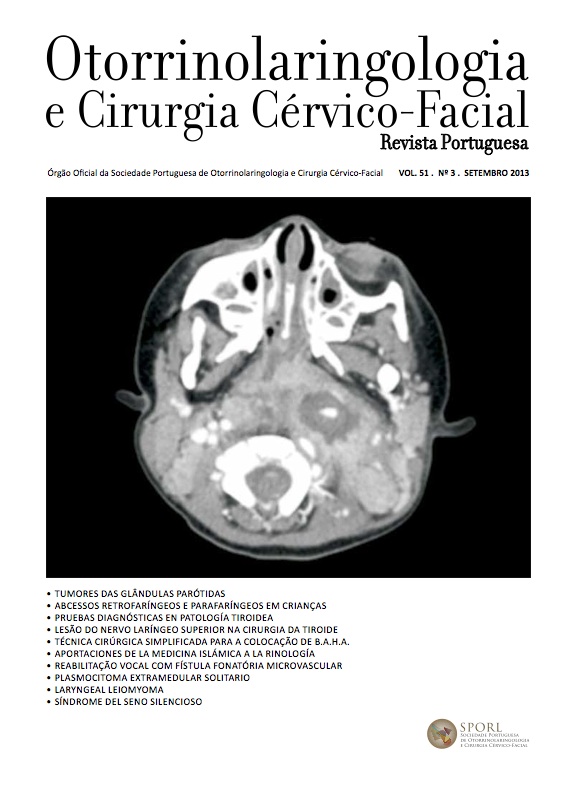Resultados clínicos da técnica cirúrgica simplificada para a colocação de implantes B.A.H.A.
DOI:
https://doi.org/10.34631/sporl.65Palavras-chave:
B.A.H.A, Técnica Cirúrgica SimplificadaResumo
Objectivos: Análise retrospectiva da técnica cirúrgica simplificada realizada com um a incisão horizontal, para colocação de implantes osteointegrados B.A.H.A., respectivas complicações e resultados clínicos.
Desenho do estudo: Estudo retrospectivo de 20 doentes implantados de Maio de 2009 a Janeiro de 2011.
Material e métodos: A técnica cirúrgica utilizada é uma variação da técnica de Nijmegen na qual se realiza uma incisão paralela à incisão retro auricular para uma cirurgia otológica convencional, seguida de remoção de tecido subcutâneo e incisão no periósteo. Apresentamos as indicações cirúrgicas e respectivos resultados clínicos assim como a taxa de complicações.
Resultados: Técnica cirúrgica de procedimento rápido, relativamente simples e que vem reduzir significativamente o número de complicações minor como necrose cutânea e formação de tecido inflamatório e de granulação na interface pele-titânio. Em 3 doentes houve extrusão do implante; em 4 registamos outras complicações minor como formação de tecido necrótico e de granulação. Não houve registo de complicações major.
Conclusão: Trata-se de uma técnica simples que reduz o tempo pér-operatório e cujas complicações são fáceis de gerir e relativamente raras, pelo que consideramos uma boa alternativa à técnica convencional para a colocação de Implantes B.A.H.A..
Downloads
Referências
Tjellström A, Lindström J, Hallen O, et al. Osseointegrated titanium implants in the temporal bone. A clinical study on bone-anchored hearing aids. Am J Otol 1981; 2:304-10.
Lustig LR, Arts HA, Brackmann DE, et al. Hearing rehabilitation using the BAHA bone-anchored hearing aid: results in 40 patients. Otl Neurotol 2001; 22:328-34.
Wasen JJ, Spitzer JB, Ghossaini SN, et al. Tran cranial contra lateral cochlear stimulation in unilateral deafness. Otolaryngol Head Neck Surg 2003; 129:248-54.
Tjellström A. Surgery for the bone –anchored hearing aid. Goteborg Medical Service Video Library 1987; 17-87.
Tjellström A. Percutaneous implants in clinical practice. CRC Crilt Rev Biocompat 1985; 205-28.
Tjellström A., Granström G. On-stage procedure to establish osteointegration: a zero to five years follow-up report. J laryngol Otol 1995; 109:593-98.
Tejellström A, Hakansson B. The bone–anchored hearing aid. Design principles, indications, and long-term clinical results. Otolaryngol Clin North Am 1995; 28:53-72.
Mylanus EAM, Cremers CWRJ. A one-stage surgical procedure for placement of percutaneous implants for the bone-anchored hearing aid. JLaryngol Otol 1994; 108:1031-5.
Mylanus EAM, Beynon AJ, Snik AFM, Cremers CWRJ. Percutaneous titanium implantation in the skull for the bone-anchored hearing aid. J Invet surg 1994; 7:327-32.
Daumau-Galofre J., Tamarit-Conejeros J.M., Murcia-Puchades V, Pons-Rocher F., Pastor-Canicio G. BAHA: nueva incisión longitudinal con implante fuera de ésta. Axta Otorrinolaringol Esp. 2009; 60(4):278-282.
Carlsson P, Hakaansson B, Rosenhall U, Tejellström A., A speech- to-noise ratio test with the bone-anchored hearing aid: a comparative study. Otolaryngol head neck Surg 1986; 94:421-6.
Niparko JK, Cox KM, Lusting LR, Comparison of the bone-anchored hearing aid implantable hearing device with contralateral routing of offside signal amplification in the rehabilitation of unilateral deafness. Otol Neurotol 2003; 24:73-8.
Wazen JJ, Spitzer JB, Ghossaini S, et al. Transcranial contralateral cochlear stimulation in unilateral deafness. Otorryngol Head Neack Surg 2003; 129:248-54.
Hol Mk, Bosman AJ, Snick AF, Mylanus EA, Cremers CW. Bone anchored hearing aids in unilateral inner ear deafness: an evaluation of audiometric and patient outcome measurements. Otol Neurotol 2005; 26:999-1006.
Hol MK, Snick AF, Mylanus EA, Cremers CW. Long term results of bone-anchored hearing aids. Arch Otoryngol Head Neck Surg 2005; 131:321-5.
Tjellström A, Granström G. Long term follow-up with the bone- anchored hearing aid: a review of the first 100 patients between 1977 and 1985. Ear Nose Throat J 1994; 73:112-4.
Holgers KM, Tjellström A. Bjursten LM, et al. Soft tissue reactions around percutaneous implants: a clinical study of soft tissue conditions around skin-penetrating titanium implants for the bone-anchored hearing aids. Am J Otol 1988; 9:56-9.
Wazen JJ, Young DL, Farrugia MC, Chandrasekhar SS, Ghossaini Sn, Borik J, et al. Successes and complications on the BAHA system. Otol Neurotol. 2008; 29: 1115-9.
Stalfors J, Tjellström A. Skin reaction after BAHA surgery: A comparison between the U-graft technique and the BAHA dermatome. Otol Neurotol. 2008; 29:1109-14.
Tjellström A, Hakansson B, Graström G. Bone-anchored hearing aids. Current status in adults and children. Otolaryngol Clin North Am. 2001; 34:337-63.






